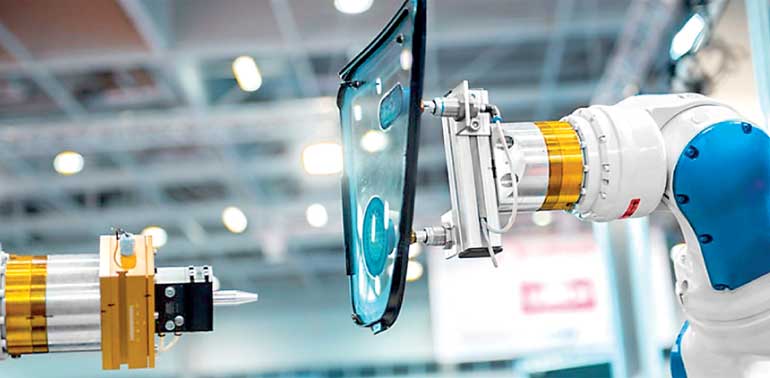Thursday Mar 06, 2025
Thursday Mar 06, 2025
Tuesday, 16 February 2016 00:02 - - {{hitsCtrl.values.hits}}
At a time when countries around the world are facing challenging circumstances around wealth creation through productive employment, the latest edition of the UNDP’s Human Development Report (2016), anchored to the theme of ‘Work for Human Development’, is timely.
Interestingly, this edition has a section dedicated to the ‘changing world of work’ and its implications, and I was asked to share some thoughts on this alongside the Sri Lanka launch of the report held in Colombo recently.
This article puts forward some ideas on the changing world of work, particularly due to technological advancements and associated shifts in the economy, and flags some challenges that they throw up for leaders in business and public policy.
 An industrial automated robot arm holding a car glass in a factory. The Fourth Industrial Revolution underway now is driven by mobile, ubiquitous digital technologies, the Internet of Things (IoT), connected devices, artificial intelligence (AI), big data, robotics, ‘autonomation’, 3D printing, human-machine interaction, and everything in between
An industrial automated robot arm holding a car glass in a factory. The Fourth Industrial Revolution underway now is driven by mobile, ubiquitous digital technologies, the Internet of Things (IoT), connected devices, artificial intelligence (AI), big data, robotics, ‘autonomation’, 3D printing, human-machine interaction, and everything in between
Technology is changing industry
The global economy is now entering what is being called the ‘Fourth Industrial Revolution’, with system-wide implications for industries and societies. The first industrial revolution came with the advent of the steam engine, giving birth to an era of mechanical progress and industrialisation. Next came electricity and mass production lines, enabling huge increases in productivity and economies of scale.
The third was computers and the internet, enabling dispersed manufacturing and birthed new sectors like ICT services. The fourth underway now is driven by mobile, ubiquitous digital technologies, the Internet of Things (IoT), connected devices, artificial intelligence (AI), big data, robotics, ‘autonomation’, 3D printing, human-machine interaction, and everything in between.
Industry, in particular, is becoming more capital intensive than ever before, and autonomous machines are driving this new round. For instance, in 2015 firms around the world deployed over 200,000 robots to replace tasks previously done by humans. Especially in economies where labour costs are high or labour is scarce, robotics are on the rise.
There are several Sri Lankan firms too that have already begun to deploy robotics in their facilities. Our labour costs are rising, our  manufacturing is not always competitive compared to low cost locations in our Asian region. So manufacturers would necessarily have to seek higher technology options that replace workers with robots. It may not be long before there is much greater ‘autonomation’ in Sri Lankan industries than there is today.
manufacturing is not always competitive compared to low cost locations in our Asian region. So manufacturers would necessarily have to seek higher technology options that replace workers with robots. It may not be long before there is much greater ‘autonomation’ in Sri Lankan industries than there is today.
But this also means that there will be a demand for new types of workers. Not workers who do the work, but workers who tell the robots how to do the work – industrial engineers with new skills, factory managers with new skills, and machine operators with new skills. While this affords immense new opportunities for new work and higher incomes, it is also challenging.
A quote in the UNDP report captures it succinctly – “There has never been a worse time to be a worker with only ordinary skills and abilities”. This has important implications on labour market and human resources policies.
Changing jobs scenario
In economics, we have a theory called ‘skill-biased technical change’, which means that as technology evolves and economies move on, people with certain skills will gain more than others. Skill-biased technical associated with the application of ICT, as well as globalised trade, has reduced demand for ‘routine’ tasks (manufacturing, clerical, back office work, etc.).
As famous labour economist late Dale Mortensen wrote in one of his last articles before his demise (November 2013), “Manufacturing occupations and administrative support used to employ millions. But technological advances have enabled many of these middle-class jobs to be automated or moved offshore – a process that is expected to accelerate with growing automation of knowledge-based activities and advances in robotics”.
In his book, ‘Fourth Industrial Revolution’, Prof. Klaus Scwhabb argues that the reasons why the new technology revolution will provoke more upheaval than the previous industrial revolutions are because of 1) the speed of change (everything is happening at a much faster pace than ever before), and 2) the breadth and depth of this change (so many radical changes happening across sectors and industries).
New opportunities for work
The effects of rapid technological advancement can be roughly placed under two types – a destruction effect and a capitalisation effect. The destruction effect occurs as technology-fuelled disruption and automation substitute capital for labour, forcing workers to become unemployed or to reallocate their skills elsewhere. The capitalisation effect is when demand for new goods and services increases and leads to the creation of new occupations, business, and even whole new industries.
On the latter, there are plenty of reasons to be optimistic. Technological changes today are offering new possibilities that we never saw before. In the robotics arena, Korean multinational Hyundai has developed robotic exoskeletons that give workers more strength. Just imagine the possibilities this affords for older workers – it gives them more strength to do industrial tasks and stay on in the workforce longer. In the additive manufacturing arena, 3D printing is helping disabled people by making them highly customisable and ultra-comfortable prosthetics, so that they can undertake jobs that were otherwise closed off to them.
There are new possibilities in flexible work practices thanks to technology. This is good for women – to have a diverse range of working options. This is good for part-timers and new entrants to the labour force. This is good for new entrepreneurs to break in to new markets with lower entry barriers. And it is good for people looking for multiple sources of income.
A friend of mine, who runs a successful dessert business, started off as a home baker but grew her business, grew her customer base, expanded her market to thousands in just months, all through a free online platform – Instagram. This is a simple but powerful example of how digital technology can bring down entry barriers to a new entrepreneur.
I recently took a taxi ride in an Uber and the driver turned out to be a driver guide working in tourism who now, with Uber, is able to get on the roads and make extra money during lull periods or in-between tour bookings. He just switches on the app and gets rides when he is in Colombo, and switches it off when he is on a tour – an additional source of revenue, and hardly any entry barriers.
Of course, these new forms of work throw up new challenges. Regulatory systems and social safety nets of the past will soon not be fit for purpose. As Prof. Schwab has argued in his book, “The challenge we face is to come up with new forms of social and employment contracts that suit the changing workforce and the evolving nature of work”.
This is a fine balance between unleashing new dynamism in labour markets, enabling people to work when, how and where they want, and preventing exploitation, rising job insecurity or precariousness, and the loss of rights to decent work. The key is also the timing and extent to which the capitalisation effects supersedes the destruction effects, and how quickly the substitution will take place.
Cannot remain behind the curve
In sum, the ‘Fourth Industrial Revolution’ can have significant impacts on labour markets and the world of work; to varying degrees, across different economies. Given the speed and spread of change, developing countries will not be isolated from these shifts. Unlike steam, transport, electricity, and computer – this latest era could see a lot more flux, more creative disruption. How it will eventually pan out for workers and for jobs remains to be seen. Economies with agile workforces, nimble educational systems, modern infrastructure, and evolving legal systems would no doubt benefit more than those without.
The change processes will only intensify, and it risks making growth unequal. But the solution isn’t to fear the change and firewall the economy from technological advancements, but to help more people in the economy gain more from the changes. In this new economy, old skills won’t help. Workers who don’t have the higher-order skills will get left out.
Policymakers in Sri Lanka seem far, far behind the curve, and risk either not reforming policy in time and having to poorly play catch up, or doing the wrong things, resulting in costly missteps. There is a critical role for leaders – both in government and the private sector – to do more to prepare the workforce of the country for this shift. Foresight can help the economy adjust to this new era and help people gain more from it than lose.
[Anushka Wijesinha is the Chief Economist of the Ceylon Chamber of Commerce (CCC) and Deputy Curator of the Global Shapers Colombo Hub of the World Economic Forum.]
Discover Kapruka, the leading online shopping platform in Sri Lanka, where you can conveniently send Gifts and Flowers to your loved ones for any event including Valentine ’s Day. Explore a wide range of popular Shopping Categories on Kapruka, including Toys, Groceries, Electronics, Birthday Cakes, Fruits, Chocolates, Flower Bouquets, Clothing, Watches, Lingerie, Gift Sets and Jewellery. Also if you’re interested in selling with Kapruka, Partner Central by Kapruka is the best solution to start with. Moreover, through Kapruka Global Shop, you can also enjoy the convenience of purchasing products from renowned platforms like Amazon and eBay and have them delivered to Sri Lanka.
Discover Kapruka, the leading online shopping platform in Sri Lanka, where you can conveniently send Gifts and Flowers to your loved ones for any event including Valentine ’s Day. Explore a wide range of popular Shopping Categories on Kapruka, including Toys, Groceries, Electronics, Birthday Cakes, Fruits, Chocolates, Flower Bouquets, Clothing, Watches, Lingerie, Gift Sets and Jewellery. Also if you’re interested in selling with Kapruka, Partner Central by Kapruka is the best solution to start with. Moreover, through Kapruka Global Shop, you can also enjoy the convenience of purchasing products from renowned platforms like Amazon and eBay and have them delivered to Sri Lanka.